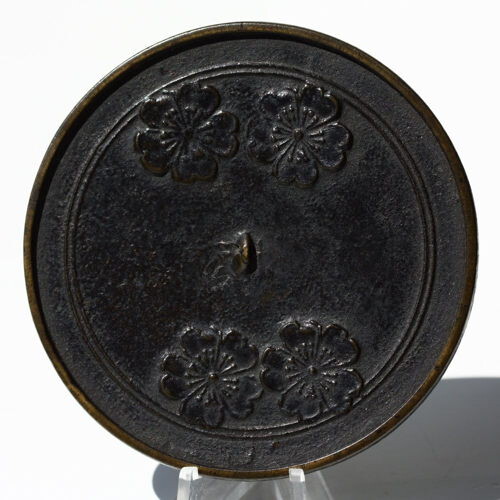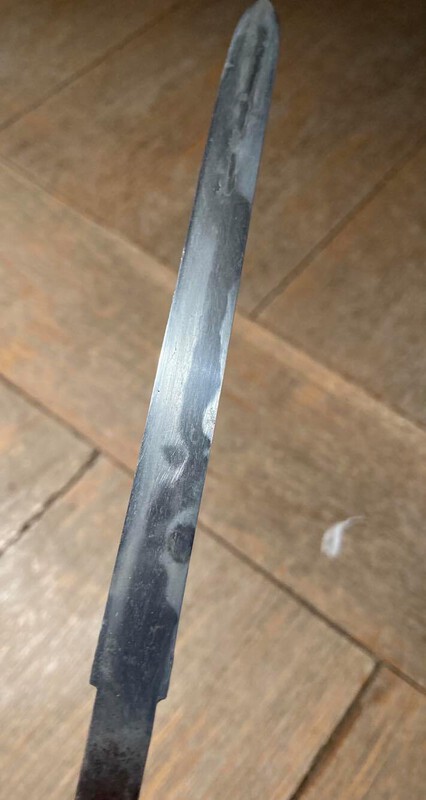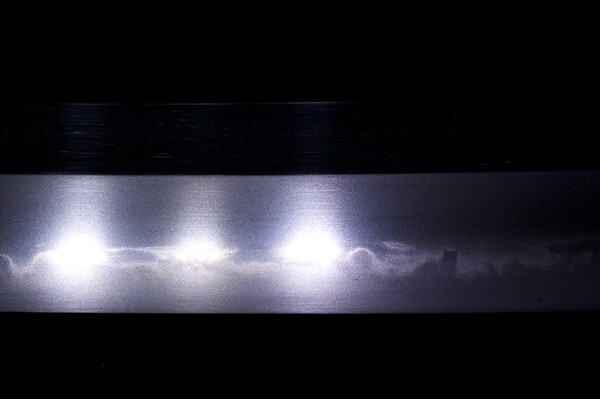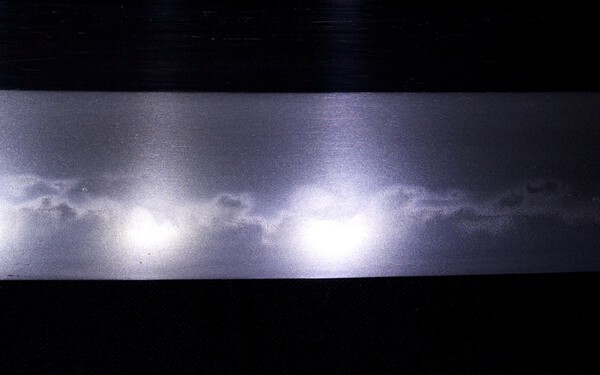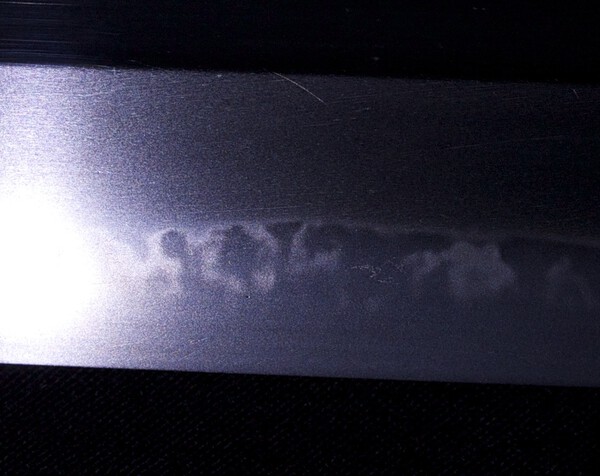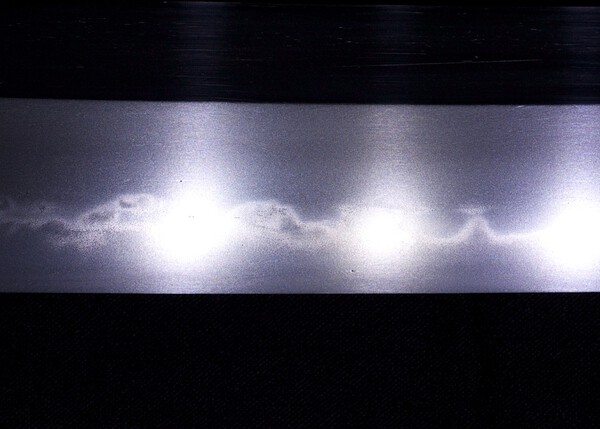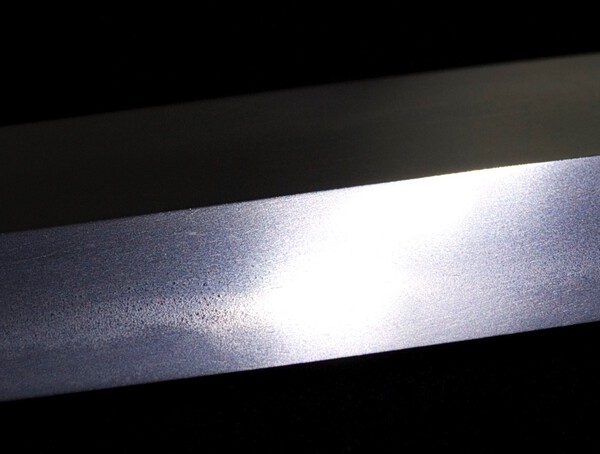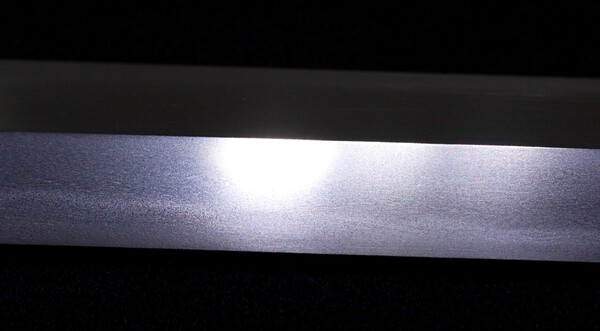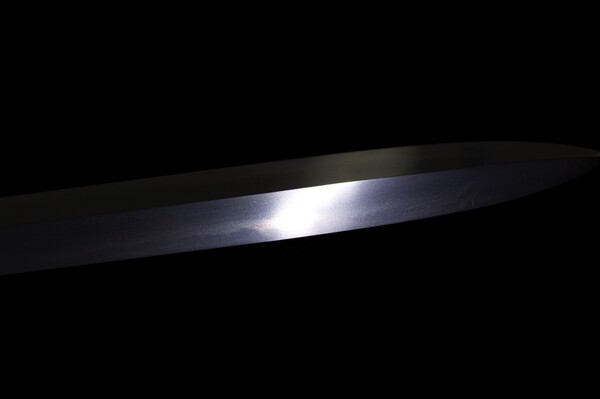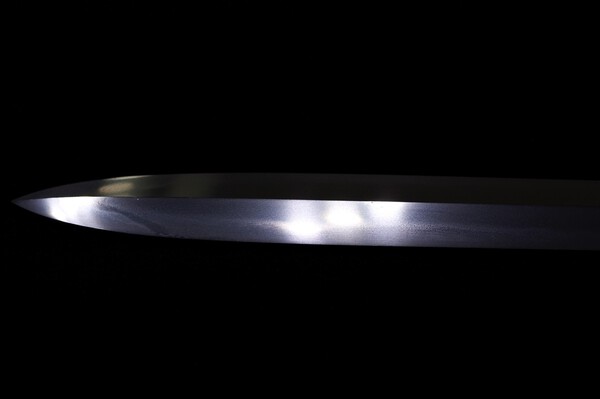-
Posts
3,105 -
Joined
-
Last visited
-
Days Won
26
Everything posted by Marius
-
Out of Japan, from a dealer of low level stuff, big name, no NBTHK paper. Draw your own conclusions
-
Kikuchi yari were straight, so this tanto wasn't one. Lovely blade, BTW.
-
Dave, Yes, I am reasonably sure. It is ubu and has no kerakubi. I understand that your question is due to the atypical shape (one side being flat), but a modified yari would most likely look differently.
-
Here is a curious blade. A 15.7cm ken, signed Hoki no kami Fujiwara Nobutaka, 3rd generation (Enpo era 1673-1681). The first photograph shows it next to a 19.4cm tanto. Ura has a flat surface, unlike in standard ken.The flat surface has a hitatsura hamon. I wonder what was the purpose of making such a diminutive blade... Enjoy
-
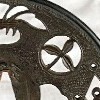
Koto Mihara wakizashi NBTHK Hozon for sale
Marius replied to Mark's topic in ASIAN ARTS & ANTIQUES LTD
May I remark that it seems just slightly suriage and machi okuri? Then again, hard to say without the sword in hand. An excellent offer, BTW. -
@Jean apologies, haven’t seen your post and posted my comment unnecessarily.
-
Glad you are not offended read this for starters: http://www.jssus.org/nkp/fake_japanese_swords.html
-
Why would one bother reading a „signature” on a Chinese fake? To wrap up: nakago has neither a proper geometry, nor finish. The signature is scratched with a sharp tool, not applied with a chisel. Sorry to be brutally honest (I really don’t want to lecture you) but these things are obvious even to a beginner. Oh, and I will spare you any comment on this abomination of a mounting. My advice (which is being repeated ofthen here): buy some books, see some real swords. Learn. Same applies to your friend. If you fail to do so and go out to buy a sword, you will spend money on worthless trash, like this one here.
-
This is not a proper nakago.
-
No hope. Sorry. This is a cheap fake.
-
This is a tricky one and those eBay pics do not tell everything and might be misleading. I see what seem to be casting bubbles in the sukashi walls. The iron looks brittle in the last picture. Must be seen in hand and scrutinised for traces of tools (chisels), evidence of folding or for tell-tale signs of casting.
-
Pm sent re T040 Gunbai sukashi
-

Hozon Jumyo Shinto Katana with Beautiful Handachi Koshirae
Marius replied to PNSSHOGUN's topic in For Sale or Trade
Congratulations to the buyer! -

Hozon Jumyo Shinto Katana with Beautiful Handachi Koshirae
Marius replied to PNSSHOGUN's topic in For Sale or Trade
Guys, this is not some cobbled together koshirae. It is a high quality item, manufactured by several artisans and very time-consuming and expensive to make. I dare say that the koshirae alone is almost worth the asking price. A splendid set. -
Correct. It is common. Of course tas you will find healthier examples. Again, it is all in the price.
-
Tom, the price has been lowered, as there were no takers when it was higher. Obvious, I know the price is probably not a screaming bargain but it seems fair. The sword is tired (polished down), nakago is deteriorated. This is all reflected in the price.
-
Have a look at this 15th c. wakizashi: http://www.ksky.ne.jp/~sumie99/sword3.html Kojima san is a Japanese sword smith (Kei'un Naohiro) and his wife runs the Usagiya online shop. Descriptions are always totally honest, sometimes to the point of discouraging potential buyers. You would get a koto - a 600 years old sword, pretty long for a wakizashi. And you can have a payment schedule.
-

Sweet Wakizashi by Yokoyama Sukekane. SOLD
Marius replied to Grey Doffin's topic in JAPANESE SWORD BOOKS & TSUBA
To all who think about this one... Please note: this is a healthy and flawless wakizashi. And it is as good as shinshinto gets - you have an excellent school, the sword is an absolute beauty (look at those choji), it comes with oshigata and of course NBTHK Hozon, all this for a very attractive price. Last not least - Grey is one of the few great gentlemen (old school in the best sense of the word) of the nihonto world. Whoever buys this sword, will be very happy! -
Quite interesting how everyone sees something different
-
The main motif looks like a bag (full with goods), the small sukashi could be either a Cintamani (wish fulfilling jewel), or a kukurizaru. You can find a bag (fukuro) on several crests and the Cimantani (hōju) in countless scrolls. I have found one painting where Hotei (bag on his shoulders) is looking at a hōju jewel: https://blogos-haha.blogspot.com/2019/08/wish-fulfilling-vases-of-void-continued.html And here is a painting with a Cimantani (hōju): https://www.schneiblefinearts.com/shop/Japanese-asian-fine-art/Japan-old-hoju-wish-granting-jewel-scroll-hand-painted-calligraphy-signed-2/ (disclosure: I am in no way associated with the seller of this painting) Kukurizaru (photo from this blog: https://www.2aussietravellers.com/walking-kyoto-ryozen-kannon/) Fukuro kamon (picture stolen from Pinterest):
-
I have recently made a purchase from the NMB. Axel (username Fuuten) has sold me a nice yamagane tsuba. It was a pleasure to deal with him and I am very happy with the purchase. The tsuba has arrived quickly. Plus, Axel is a really nice guy
- 1 reply
-
- 9
-

-

-
JT, sorry to say, but your tanto seems to be very very low quality (at least in your photographs, but it might also be the polish). It if were a Hosho utsushi by a reputable sword smith it would have looked way superior. Masame as such is not an indication of quality, it is just a way of arranging layers during the forging of iron (steel). I suggest you don't focus on the least important factor in the quality of the sword... No matter what hada, a sword can be bad or excellent. `Please dive into this excellent resource by Kojima Hiroshi, a Japanese sword smith: http://www.ksky.ne.jp/~sumie99/information.html
-
Not really, just a few, (they focus on steel and I have no pics of the sugata of my own): My katana by Kojima: My ken by Kojima:

